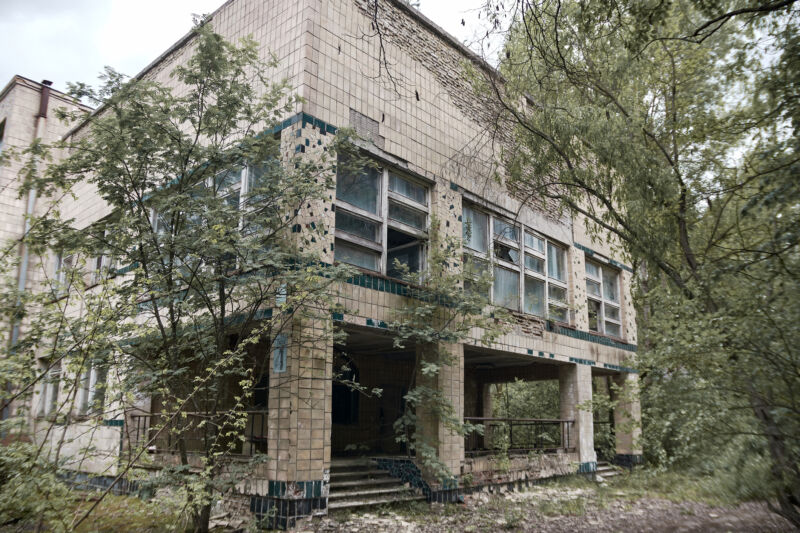Exposed —
A deep look into the genetic damage left by the disaster.
John Timmer
–

Enlarge / Trees grow near a former hospital in a town abandoned due to the Chernobyl disaster.
Chernobyl is generally recognized as the worst nuclear accident on record, directly killing 31 people and causing widespread contamination in Eurasia. It’s estimated that thousands of people will eventually die earlier than they would have due to the cancers caused by their exposure.
Now, international teams of researchers have looked at the genetic damage that’s the legacy of Chernobyl exposures. One group looked at the genetic changes found in thyroid tumors that have been linked to exposure to the radioactive iodine spewed out during the disaster. And another team looked at the children of people assigned to the Chernobyl cleanup and found that the damage seems to be limited to those exposed rather than being passed down.
Radiation and DNA
Radiation causes long-term problems because it can cause damage to our DNA. The precise nature of the damage, however, is complicated. The radiation can damage individual bases of DNA, leading to minor mutations. But it can also make breaks in both of the strands of DNA’s double helix (which biologists creatively call “double-stranded breaks”).
These breaks are then handled by the cell’s DNA repair system, with varying results. In some cases, they are probably repaired properly and the cell carries on. In others, however, mistakes get made during the repair. These are often short deletions: a few bases around the site of the damage are cut away, and the two ends of the break are reconnected. In others, large areas around the break get deleted entirely. And, in some cases, the repair system gets badly confused and links the damaged pieces to areas elsewhere in the genome, creating a complex rearrangement.
How this plays out in the human body is also complicated. Exposure from an external source may be relatively uniform, but if a radioactive isotope is ingested in some way, it may gather in a specific tissue. Iodine, for example, ends up in the thyroid, which uses it to synthesize a hormone; strontium is chemically similar to calcium and so winds up in the bones; etc. Different isotopes also produce different types of radiation at distinct energies, which can be more or less likely to cause specific types of DNA damage.
All of that is to say that there’s no simple way to predict the consequences of exposure from Chernobyl. We have some expectations based on other incidents of radiation exposure, but our understanding is limited.
Checking the genes
Chernobyl is, among many other things, a chance to improve our understanding. And so different teams have been tracking the health of people exposed to its radiation or isotopes. One of the two new studies looks at people termed “liquidators,” who played critical roles in the initial cleanup, and residents of the closest town, called Pripyat. At the time, most of these people had their exposure levels tracked carefully, allowing the researchers to correlate any changes in their DNA with their exposure.
The study did genome sequencing for both those exposed and their children, which allowed the researchers to detect how many new mutations had been inherited from those exposed. A number of new mutations appear with each generation, so the team was looking at a higher rate than found in controls born after the event.
And the researchers found nothing. Their search was sensitive enough that they were able to detect the effect of parental age on the number of new mutations (old parents pass on more mutations to their offspring), but it saw no effect from the dose of radiation their parents had received. Parental smoking and drinking had no impact on their offspring’s DNA as well.
One of the radioactive elements spread widely by Chernobyl was a radioactive isotope of iodine, which causes elevated thyroid cancers. As expected, a number of people exposed to the Chernobyl debris have since developed this cancer, and the researchers obtained both cancerous and healthy tissue from them. Again, they sequenced the genomes and looked at the mutations that occurred in these cancers.
Spared
As cancerous cells often tend to pick up additional DNA damage for a variety of reasons, all of the samples had mutations. So the researchers focused on identifying the types of mutations that increased with increasing exposure. The class that was most notably increased by radiation exposure was small deletions, typically caused by repair of a double-stranded break in the DNA. Double-stranded breaks that led to larger rearrangements, such as exchange of DNA between chromosomes, were also boosted by exposure.
In some cases, these mutations seemed to be directly connected to the genetic damage that drove the cancer itself. In other cases, the connection was difficult to determine.
Overall, the big news is that, even though the radiation exposure appears to have been sufficient to cause extensive DNA damage and cancer, it doesn’t appear that this damage is being passed on to future generations at an appreciable rate. So, while Chernobyl has left a horrifying legacy, there are limits to how far the legacy is likely to spread.
Science, 2021. DOI: 10.1126/science.abg2538, 10.1126/science.abg2365 (About DOIs).

